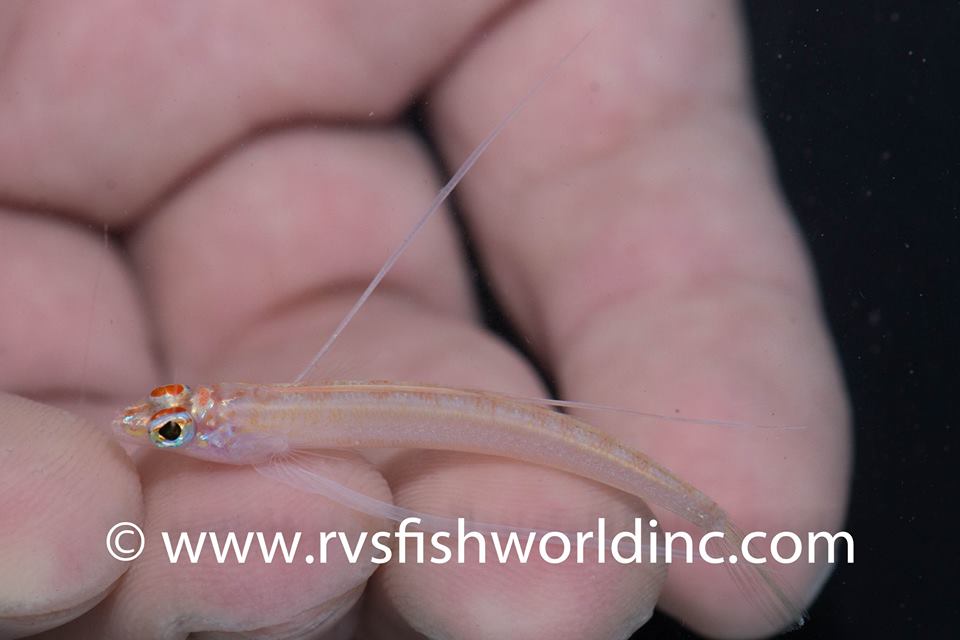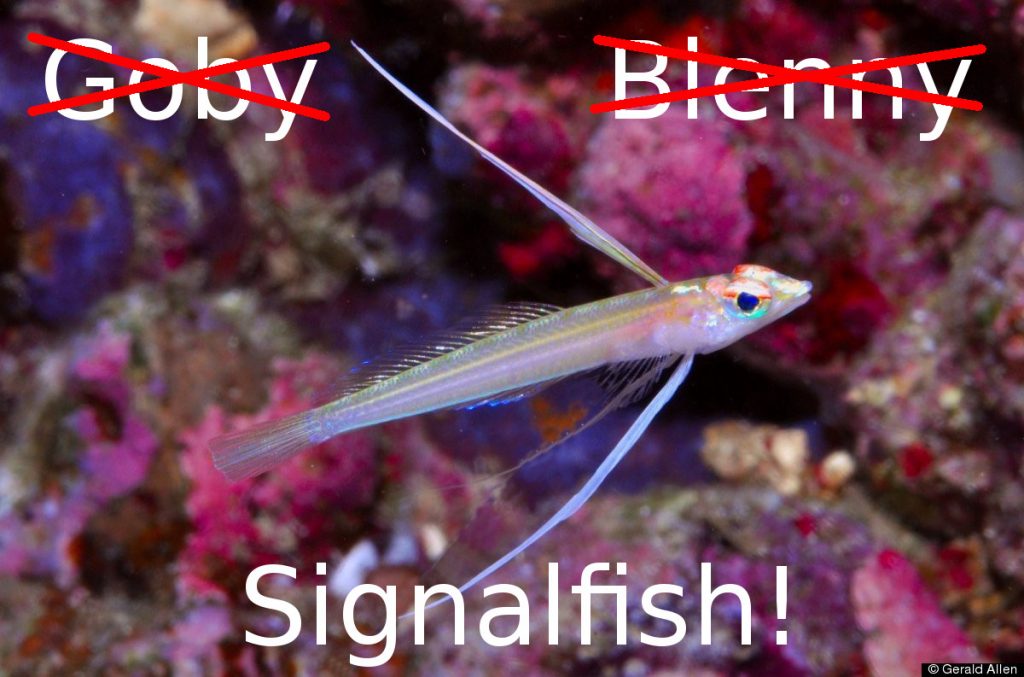For what might be the very first time, a Signalfish has been collected for the aquarium trade. These captivating little fishes are poorly known thanks to their penchant for the kinds of deep, silty habitats which attract few recreational divers (and even fewer aquarium collectors). But, despite their continued obscurity, signalfishes have much to offer the home aquarist. These are graceful and gorgeous creatures which display some fascinating behavioral quirks.

Midwater Signalfish (Pteropsaron longipinnis), male, from Zambales, Philippines. Credit: Barnett Shutman RVS Fishworld
The species seen here is the Midwater Signalfish (Pteropsaron longipinnis), and it is unquestionably one of the most visually striking members of its genus thanks to its dramatically elongated pelvic fins. All other members of the group have considerably smaller pelvic fins which they rest upon in a goby-like manner, but P. longipinnis has eschewed this lifestyle. Instead of squatting atop the silted ocean floor, the Midwater Signalfish, true to its name, floats about in a graceful manner just above the substrate, dangling its flamboyant finnage to ostentatious effect. When spooked, it will, however, quickly dive beneath the surface.

Pteropsaron longipinnis male (left) and female (lower right) at 30 meters in Palau. Credit: smd4882345
The species is sexually dimorphic, as are likely all members of this genus. Males possess an exaggerated first dorsal fin, equal in length to the pelvic fins, which can be dramatically held high when displaying to females or rival males. Females, on the other hand, have a considerably shorter fin, which is black in color. In the closely related P. springeri, the females are known to flick this fin with a sudden, jerky motion, but it remains unknown what purpose this serves and if this behavior extends to others in the genus. With specimens now trickling into the hands of aquarists, there is a real opportunity for hobbyists to contribute to our understanding of how these fish communicate among one another.
As far as aquarium care, this little fish should be expected to feed readily on things like mysis and brine shrimp (and possibly flake and pellet foods, though this remains to be tested). It can probably be assumed that this is a fairly timid species, so tankmates should obviously be chosen with great care. In the wild, you can find signalfishes hanging around with the likes of Tryssogobius, Vanderhorstia, Oxymetopon and other muck-associated groups. They are said to occur in harems of 15-20 individuals, with only a few males present. This social structure raises the question of whether signalfishes might be protogynous hermaphrodites, but the apparent lack of specimens with intermediate fin morphology might argue against this hypothesis. More study is needed. Whether or not a large group can be successfully maintained in captivity will be an interesting experiment to be tested, but it’s hard to imagine that such a graceful creature could pose any real threat to itself or others. Lastly, it is reported that their preferred habitat is dominated by swift currents and somewhat cooler waters (24℃).
The specimens collected by RVS Fishworld represent a considerable range extension for P. longipinnis; Barnett Shutman informs me that these were found at Masinloc, Zambales, which is on the western side of the northern island of Luzon in the Philippines. Previously, this species has been documented from a handful of locations in the West Pacific (Palau, Tinian, Alor, Timor), and it was originally described in 2012 from Cenderawasih Bay, on the island of New Guinea, at 70m.
As a final note on this discovery, I’d like to reiterate a point I made in my earlier review on this group. Signalfishes are not gobies. Not even remotely. They aren’t blennies either. And they aren’t sand-divers, though you’ll see them classified as such in most references online and in print. Instead, signalfishes belong to the recently recognized Hemerocoetidae, which includes a handful of obscure genera that make a living in deeper benthic habitats. Their closest relatives appear to be the sandburrowers (Creediidae), another small family that aquarists almost never see. Both groups share a similar overall shape and are closely associated with silty or sandy substrates. So, please, I know the temptation is strong, but don’t call P. longipinnis a goby or blenny… it’s a signalfish. Much like David S. Pumpkins, Pteropsaron is its own thing.












0 Comments